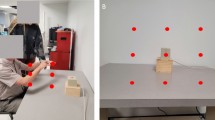Abstract
We can accurately reach to touch our index fingertip to various points on the body without vision. Awareness of location/motion of the index fingertip and other body parts through proprioception is required for such movements. Proprioception involves processing sensory information, but it is also debated whether internal model estimates of body state from motor commands improve proprioception. We tested the hypothesis that proprioceptive errors increase with increases in speed of hand movement and whether an internal model contributes to more accurate proprioception, especially in higher speed movements. Ten subjects made voluntary reaching movements with their dominant arm to touch its index-tip to the index-tip of the non-dominant arm that was moved passively or actively at three speeds (slow, comfortable, fast) in various directions. Four conditions required the experimenter to passively move the subject’s target arm at slow, comfortable and fast speeds and in different directions. A fifth condition required the subject to actively move both arms to perform the task. Subjects performed these tasks with high accuracy during slow and comfortable speed movements of the target arm. Errors averaged 3.7 mm larger when the target was moved faster and were equivalent to errors for slower movements (p < 0.014). Errors in the active and passive target movement conditions were also equivalent (p < 0.001). These findings show that proprioception is accurate across many different speeds of passive and active target motion and that there was no evidence than an internal model contributes to improved accuracy of proprioception during active movements.







Similar content being viewed by others
Data availability
Some data generated during and/or analysed during the current study are available at https://osf.io/rgpyu/?view_only=3775aeea55da4343bcb077e5a8c1c9e7.
References
Bhanpuri NH, Okamura AM, Bastian AJ (2013) Predictive modeling by the cerebellum improves proprioception. J Neurosci 33:14301–14306
Boisgontier MP, Nougier V (2013) Ageing of internal models: from a continuous to an intermittent proprioceptive control of movement. Age (dordr) 35:1339–1355
Boisgontier MP, Swinner SP (2014) Proprioception in the cerebellum. Front Hum Neurosci 8:212
Capaday C, Darling WG, Stanek K, Van Vreeswijk C (2013) Pointing to oneself: active versus passive proprioception revisited and implications for internal models of motor system function. Exp Brain Res 229:171–180. https://doi.org/10.1007/s00221-013-3603-4
Darling WG, Wall BM, Coffman CR, Capaday C (2018) Pointing to one’s moving hand: putative internal models do not contribute to proprioceptive acuity. Front Hum Neurosci. https://doi.org/10.3389/fnhum.2018.00177
Fitts PM (1954) The information capacity of the human motor system in controlling the amplitude of movement. J Exp Psychol 47:381–391. https://doi.org/10.1037/h0055392
Fuentes CT, Bastian AJ (2010) Where is your arm? Variations in proprioception across space and tasks. J Neurophysiol 103:164–171. https://doi.org/10.1152/jn.00494.2009
Goble DJ, Brown SH (2009) Dynamic proprioceptive target matching behavior in the upper limb: effects of speed, task difficulty and arm/hemisphere asymmetries. Behav Brain Res 200:7–14. https://doi.org/10.1016/j.bbr.2008.11.034
Goble DJ, Brown SH (2010) Upper limb asymmetries in the perception of proprioceptively determined dynamic position sense. J Exp Psychol Hum Percept Perform 36:768–775. https://doi.org/10.1037/a0018392
Gritsenko V, Krouchev NI, Kalaska JF (2007) Afferent input, efference copy, signal noise, and biases in perception of joint angle during active versus passive elbow movements. J Neurophysiol 98:1140–1154. https://doi.org/10.1152/jn.00162.2007
Jones SA, Cressman EK, Henriques DY (2010) Proprioceptive localization of the left and right hands. Exp Brain Res 204:373–383. https://doi.org/10.1007/s00221-009-2079-8
Kerr GK, Worringham CJ (2002) Velocity perception and proprioception. Adv Exp Med Biol 508:79–86. https://doi.org/10.1007/978-1-4615-0713-0_10
Lonn J, Djupsjobacka M, Johansson H (2001) Replication and discrimination of limb movement velocity. Somatosens Mot Res 18:76–82
Maleki-Ghahfarokhi A, Dianat I, Feizi H, Asghari-Jafarabadi M (2019) Influences of gender, hand dominance, and anthropometric characteristics on different types of pinch strength: a partial least squares (PLS) approach. Appl Ergon 79:9–16. https://doi.org/10.1016/j.apergo.2019.04.002
Monaco S, Kroliczak G, Quinlan DJ, Fattori P, Galletti C, Goodale MA, Culham JC (2010) Contribution of visual and proprioceptive information to the precision of reaching movements. Exp Brain Res 202:15–32. https://doi.org/10.1007/s00221-009-2106-9
Paillard J, Brouchon M (1968) Active and passive movements in the calibration of motion sense. In: Freedman S (ed) The neuropsychology of spatially oriented behavior. Dorsey, Homewood, pp 37–55
Proske U, Gandevia SC (2012) The proprioceptive senses: their roles in signaling body shape, body position and movement, and muscle force. Physiol Rev 92:1651–1697. https://doi.org/10.1152/physrev.00048.2011
Sciutti A, Squeri V, Gori M, Masia I, Sandini G, Konczak J (2010) Predicted sensory feedback derived from motor commands does not improve haptic sensitivity. Exp Brain Res 200:259–267
van Beers RJ, Sittig AC, Denier van der Gon JJ (1998) The precision of proprioceptive position sense. Exp Brain Res 122:367–377
Wolpert DM, Ghahramani Z (2000) Computational principles of movement neuroscience. Nat Neurosci 3(Suppl):1212–1217. https://doi.org/10.1038/81497
Wolpert DM, Ghahramani Z, Jordan MI (1995) An internal model for sensorimotor integration. Science 269:1880–1882
Author information
Authors and Affiliations
Corresponding author
Ethics declarations
Conflict of interest
On behalf of all authors, the corresponding author states that there is no conflict of interest.
Additional information
Communicated by Bill J Yates.
Publisher's Note
Springer Nature remains neutral with regard to jurisdictional claims in published maps and institutional affiliations.
Rights and permissions
About this article
Cite this article
Yoss, A.L., Zuck, B.I., Yem, J.A. et al. High proprioceptive acuity in slow and fast hand movements. Exp Brain Res 240, 1791–1800 (2022). https://doi.org/10.1007/s00221-022-06362-2
Received:
Accepted:
Published:
Issue Date:
DOI: https://doi.org/10.1007/s00221-022-06362-2




